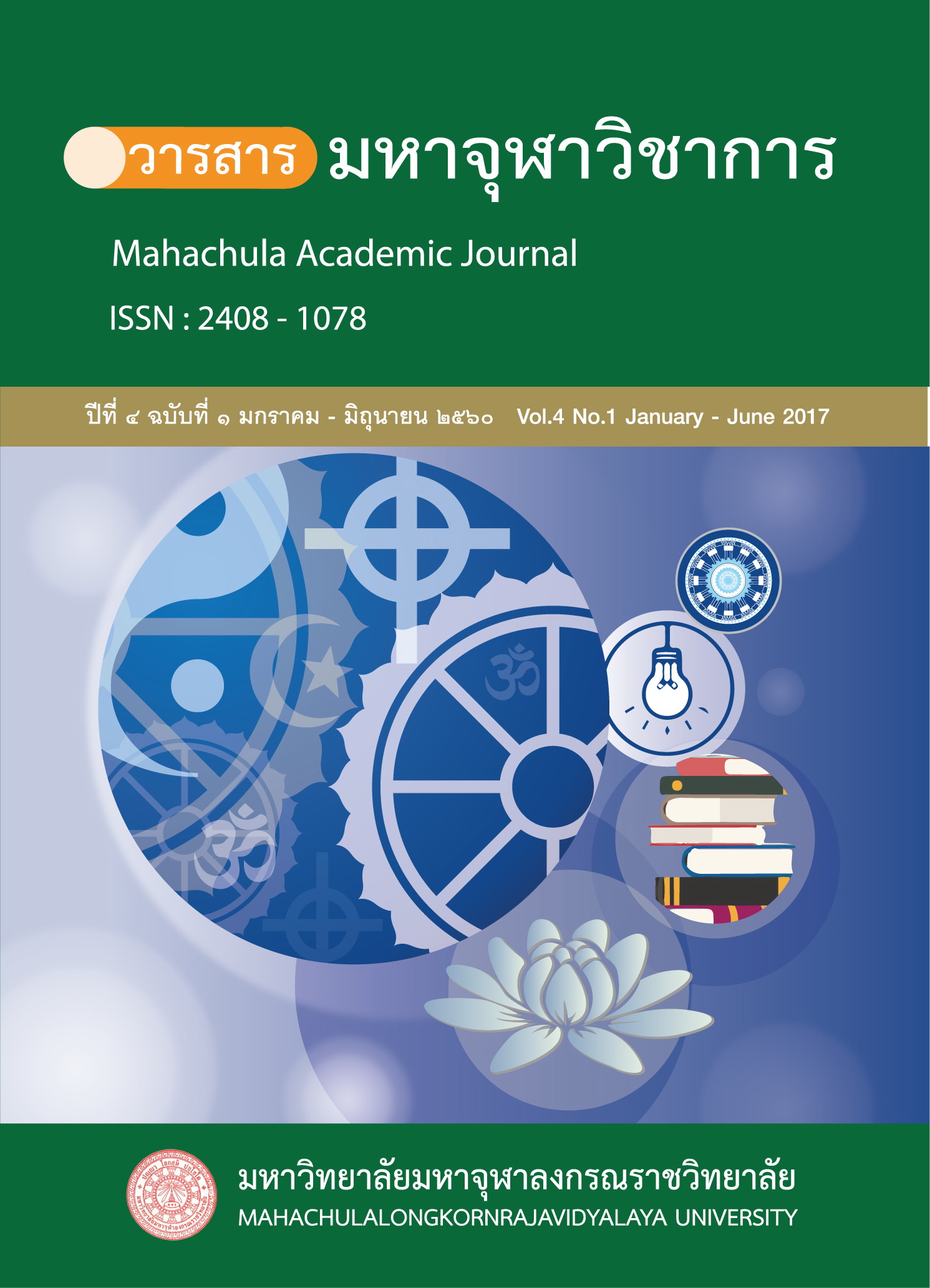An Analytical Study of Haephakhuenthat Festival, Wat Phramahatat Woramahavihara, Nakhonsithammarat Province
Main Article Content
Abstract
The research objectives were as follows 1) To study the history, belief, form and behavior performance on Haephakuenthat festival, Wat Phramahatatuvoramahavihara, Nakhonsithammarat province, the population were composed of Venerable monks scholars, and common people who came for performing on this festival all about 15 person, the instrument for data collection was dept interview question and observation without participation, data analysis by finding the similar or non-similar, relation and different then collected data for investigation and reliability and present data by dissemination in items according to content by analyze description The findings were as follows.
1. According to history and belief on Haephakuenthat festival found that on 1773 B.E. Sridhammasokaraj king had already fixed of Pagada then arranged for cerebration and some of Pakpanang people had offered the speech on about lord Buddha image story painting which found at Pakpanang beach and taken that cloth to offer the King then after clean the cloth found the lord Buddha image painting that called Phaphrabod then announce for finding the owner and found that the owner was the Buddhist from Hengsawadee, Mynmar and some found the owner from Intarapat, Cambodia to bring Phaphrabod for woshiping lord Buddha in Langka, The king had decided to bring this cloth for covering the pagoda on Cerebration ceremony this festival had appeared up to the present time, they believed that read worship must do in front
of the Buddha face only, the people in Nakhon Si Thammarat city bring Phaphrabod for covring the pagoda by cover the pagoda as closed with Buddha relic.
2. The form and performance behavior on Haephakuenthat festival started with determination on date for worshiping in two times per year but now has only one time i.e. on Makhapujâ day, the cloth for covering pagoda used the white, yellow and red. The Buddhist people will prepare the long cloth according to their belief, then bind each other of their cloths to cover the pagoda in all a round, and the special one must paint the lord Buddha image on his history, the start point began at Sanamnamuang, they cerebrate with a lots of foods and sweets etc, and offered to monks in wat pramahatatuvoramahavihara by carrying with beautiful parade and roaming with traditional music in front of parade, enjoy and every one took so long line and kept
the cloth on their heads, and walk throughout the Rajadamnern Road, while the parade reached the temple and then take three rounds of pagoda and then to perform with praying and invited the monks for chanting and then offer the Phrabod by speech then bring the cloth in to Phratrongma Vihara, some group had many people, some group had a few of them, to offer food for monk in morning and then to bring the cloth to
cerebrate at seven o’clock start the cloth line, lots of them brought the cloth to cover the pagoda without form depended upon their require but the cloth line of offician would cerebrate in the afternoon and did not took around the pagoda, and in the parade line also were prepared a lots of flowers, candles etc, for worshiping the pagoda and also arranged with traditional music played along the parade line all the way and
also had many dancers who dressed in white cloths or silk etc, some of them, they had full beliefs and took off their shoes for walking around with cloth in the noon and some parade had monks walking in front of the parade line
Article Details
References
กาญจนา สวนประดิษฐ์. “ผีตาโขน : ศึกษาเฉพาะกรณีอำเภอด่านซ้าย จังหวัดเลย”. วิทยานิพนธ์การศึกษามหาบัณฑิต, บัณฑิตวิทยาลัย: มหาวิทยาลัยมหาสารคาม, ๒๕๔๓.
กิ่งแก้ว อัตถากร. คติชนวิทยา. กรุงเทพมหานคร: โรงพิมพ์คุรุสภาลาดพร้าว, ๒๕๒๐.
จารุเกตุ กาญจนนาภา. “ประเพณีรามัญในอำเภอประประแดง จังหวัดสมุทรปราการ”. วิทยานิพนธ์ศิลปศาสตรมหาบัณฑิต. บัณฑิตวิทยาลัย: มหาวิทยาลัยศิลปากร, ๒๕๔๓.
จารุวรรณ ธรรมวัตร. คติชาวบ้านอีสาน. กรุงเทพมหานคร: สำนักพิมพ์อักษรวัฒนา, ๒๕๔๘.
จันทรา ทองสมัคร. ประเพณีท้องถิ่นนครศรีธรรมราช. นครศรีธรรมราช, ๒๕๔๐.
ณรงค์ บุญสวยขวัญ. “วิถีชีวิตของประชาชนในพื้นที่ลุ่มน้ำปากพนัง อันเนื่องมาจากการพัฒนาของรัฐในระยะแผนพัฒนาฉบับที่ ๑-๘”. วิจัยเรื่องโครงสร้างและพลวัตวัฒนธรรมภาคใต้กับการพัฒนาของเมธีวิจัยอาวุโส ศาสตราจารย์สุธิวงศ์ พงศ์ไพบูลย์. สำนักงานกองทุน
สนับสนุนการวิจัย, ๒๕๔๓.
ถนอมศิลป์ โทบุญ. “โลกทัศน์ต่อประเพณีบุญบั้งไฟของชาวตำบลหนองแสง อำเภอวาปีปทุม จังหวัดมหาสารคาม”. วิทยานิพนธ์ศึกษาศาสตรมหาบัณฑิต. บัณฑิตวิทยาลัย: มหาวิทยาลัยมหาสารคาม, ๒๕๔๐.
ทิพย์สุดา นัยพันธ์. ภาษากับวัฒนธรรม. กรุงเทพมหานคร: โรงพิมพ์การศาสนา, ๒๕๓๕.
บุปผา ทวีสุข. คติชาวบ้าน. กรุงเทพมหานคร: โรงพิมพ์มหาวิทยาลัยรามคำแหง, ๒๕๒๐.
ประมวล พิมพ์เสน. ความเชื่อเรื่องผี เล่ม ๔. ขอนแก่น: โรงพิมพ์พระธรรมขันต์, ๒๕๔๖.
ปรีชา นุ่นสุข. “วัดพระมหาธาตุวรมหาวิหาร” ใน รัตนธัชมุนีอนุสรณ์ ที่ระลึกงานพระราชทานพระมหาธนูฤทธิ์ ดวงดี. “ความสัมพันธ์ของชุมชนสองฝั่งโขง ในประเพณีฮีตสิบสอง: กรณีชุมชนวัดมีชัย อำเภอเมืองหนองคาย จังหวัดหนองคาย กับชาวบ้านท่าม่วง เมืองหาดทรายฟองกำแพงนครเวียงจันทร์”. การศึกษาค้นคว้าอิสระ. บัณฑิตวิทยาลัย: มหาวิทยาลัยมหาสารคาม, ๒๕๔๓.
พวงผกา คุโรวาท. ศิลปะและวัฒนธรรมไทย. กรุงเทพมหานคร : รวมสาสน์, ๒๕๓๙.
พวงพิกุล มัชฌิมา. “บุญข้าวประดับดินและบุญข้าวสากบ้านกุดรัง ตำบลกุดรัง อำเภอบรบือ จังหวัดมหาสารคาม”. วิทยานิพนธ์ศึกษาศาสตรมหาบัณฑิต. บัณฑิตวิทยาลัย: มหาวิทยาลัยมหาสารคาม, ๒๕๔๒.
พิชญ์ สมพอง. สังคมชาวบ้าน. กรุงเทพมหานคร: โรงพิมพ์มหาวิทยาลัยรามคำแหง, ๒๕๒๒.
ภักดี เอื้อราษฎร์. “การศึกษาเปรียบเทียบประเพณีบุญพระเวสของจังหวัดร้อยเอ็ดกับบ้านบ่อใหญ่ตำบลบ่อใหญ่ อำเภอบรบือ จังหวัดมหาสารคาม. วิทยานิพนธ์ศึกษาศาสตรมหาบัณฑิต. บัณฑิตวิทยาลัย: มหาวิทยาลัยมหาสารคาม, ๒๕๔๐.
รัตนา สิงห์พร. “ประเพณีทำบุญแจกข้าวของชาวบ้านบ่อใหญ่ ตำบลบ่อใหญ่ อำเภอบรบือ จังหวัดมหาสารคาม”. วิทยานิพนธ์ศึกษาศาสตรมหาบัณฑิต. บัณฑิตวิทยาลัย : มหาวิทยาลัยมหาสารคาม, ๒๕๔๒.
วัฒนา จันทรจนา. “ประเพณีลากพระของชาวจังหวัดปัตตานี”. ปริญญาศิลปศาสตรมหาบัณฑิต. บัณฑิตวิทยาลัย: มหาวิทยาลัยศรีนครินทรวิโรฒ ภาคใต้, ๒๕๓๗.
วิทยาลัยครูนครศรีธรรมราช. ชีวิตไทยปักษ์ใต้. กรุงเทพมหานคร: โรงพิมพ์อักษรสัมพันธ์, ๒๕๑๙.
สุเมธ ชุมสาย ณ อยุธยา. น้ำ : บ่อเกิดแห่งวัฒนธรรมไทย. โรงพิมพ์อักษรสัมพันธ์, ๒๕๒๘.
สุพัตรา สุภาพ. สังคมและวัฒนธรรมไทย. กรุงเทพมหานคร : ไทยวัฒนาพานิช, ๒๕๑๘.
สมเด็จพระญาณสังวร. หลักพระพุทธศาสนา. กรุงเทพมหานคร: สำนักพิมพ์พัฒนาศึกษา, ๒๕๑๖.
สมพงษ์ เกรียงไกรเพชร. ประเพณีไทยโบราณ. กรุงเทพมหานคร: โรงพิมพ์จรัลสนิทวงศ์, ๒๕๑๕.
เสถียร โกเศศ. (พระยาอนุมานราชธน). การศึกษาเรื่องประเพณีไทยและชีวิตชาวไทยสมัยก่อน. กรุงเทพมหานคร: คลังวิทยา, ๒๕๑๕.
Mavis Hiltunen Biesanz and John Beisanz. Op,cit. Popeonoe. David. Sociology. (4 th. Ed,), Englewood Cliffs. New Jersey : Prentice-Hall. Inc., 1980.
Theodore Coplow, Po.cit. Webster’s Thrd New International Dictionanry. Springfield Massachusetts : G & C Merriam Co., 1996.


